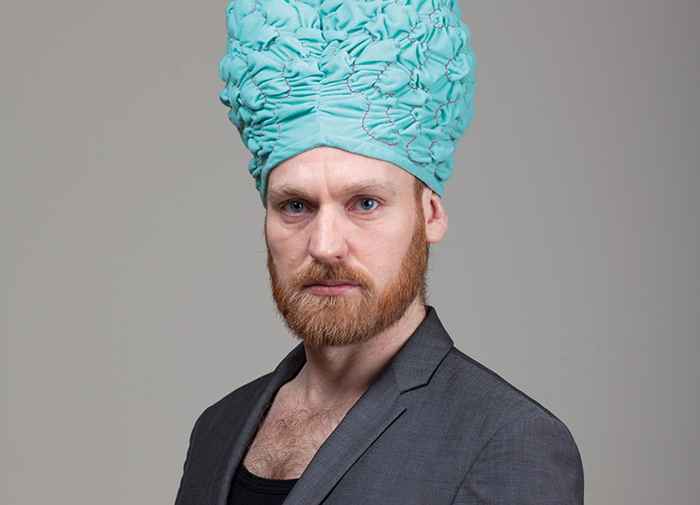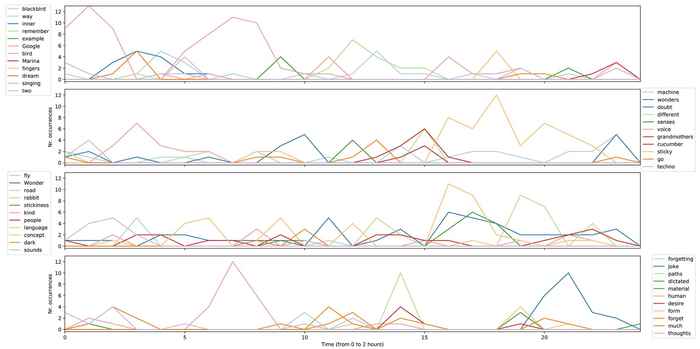Orion Maxted on theatre and collective thinking as a bridge between art and science
23 June 2021

Orion Maxted: “The Interactions Group hold weekly meetings, as well as workshops and performances, bringing together a diverse range of artists, philosophers and scientists, who together explore the weird and wonderful folds in the dimensions of all possible collective human computation. Our inspirations include algorithmic theatre, collective intelligence, poetry, and complex adaptive systems sciences with the goal of developing conversations about what art and science can be, and how to relate performance to complexity science. Our approach to this topic is to work closely together on the very question of collective thinking. Moreover, the Interactions project is the formulation of the group itself. Thinking about the group as a complex self-organising system, how can we better understand the ingenuity of complex adaptive systems through this living model of collective thought? Conversely, can we borrow ideas from complexity in order to organize a group that organizes itself - whilst simultaneously proposing practical new forms of collective thought, collective feeling, and collective being? For obvious reasons, much of our work in the past eighteen months has taken place through Zoom and other online platforms. Taking advantage of the limitations of a digital platform has highlighted the importance of conversation structures. Imagining conversation as a complex adaptive phenomenon with emerging properties hinging upon the interactions of the groups’ agents.
How do collective thinking and discussion usually take place? How might we reprogram conversation by changing its rules and constraints. It’s an open-ended approach to conversation as an algorithmic composition, which has real implications for how we think together, especially in a transdisciplinary context like IAS”.
The group’s weekly collaborative experiments have led to public performance, including Negative Poetry, a collaboration with Interactions member Katarina Petrovic; The Wonder Machine, and Wandering Together and Alone - a piece about swarming and social distancing.
How can a conversation become a performance?
“Traditionally, a theatre performance is thought of as a ‘fixed’ script, of words and direction which is rehearsed and repeated over and over in the same sequence. Our approach is to think about performance as a model of a complex adaptive system, or, to put it another way, as collective thinking. Instead of a fixed script, we give the agents rules and/or constraints, which govern how they interact, listen and intra-act. The performance emerges through this process, and just as with conversation, we don’t try to control every aspect, but rather, set up a system and follow the dynamics of the system.”
For most of the researchers involved this was the first time they had interacted in such a way.
“I think a lot of the work we do is about building a shared vocabulary between artists and scientists. The fundamental difficulty in artscience is that the ideas you are able to cocreate are limited by the degree to which you are able to cultivate a shared language around a shared set of practices.”

A major part of The Interactions Group is devising systems and playing games that generate collective thinking.
“One of the performance systems we have devised is called The Wonder Machine; a game that generates wonderment - which we see as a key overlapping theme between art and science.
In this compacted, systematised, form of conversation, each agent speaks in turn, beginning with the phrase ‘I wonder…’ expressing their current state of curiosity.
The complexity of the collective emergence that arises, makes the simplicity of the underlying rule-set all the more fascinating. Like a swarm or flock or set of neurons - the agents must simultaneously propose relationships and ideas - in the form of wondering - and receive i.e. listen to the relationships and ideas proposed by the other agents. You hear and participate in decentralisation, emergence, and self-organisation as it is happening in real-time as ideas take the group in directions that no one individual can predict or control.
All each participant has to do is say something they wonder about - i.e. are curious about, thinking about, or in a state of awe (wonderment) about. As in conversation, there is turn-taking, but the turn-taking is more strict, like a game.
One of the interesting features that inevitably emerges, is how the agents’ wonderings often merge and co-produce the wonderings of the other agents, even though there is no explicit rule to do so. I suppose it's because each wonder which is expressed triggers patterns of activation in each of the other participants. This increases the activation level of each pattern and its ‘weight’ in the brain of each participant. As more and more wonders are spoken, each one activating patterns, each incrementally adding weightings within the neural networks. These patterns start to propagate further and eventually interact with each other, forming new patterns and new intuitions, which are then intuitively expressed by one of the participants, thus further adding to the weighting in the other participants. For a while, a dominant topic of wondering will emerge, a temporary goal state, which will lead to other wonderings, until the current collective goal state is perturbed by a new pattern. This is operating at the level of the whole system of participants, with ideas forming on a pre-symbolic and collective level, leading to the creation of new ideas. We can chart the rise and fall of ideas in the collective brain through time. (See diagram)
And so what we find very interesting here, is that through the interactions and feedback loops of primings and wonders, a simple yet surprising form of collective thinking arises - a collective mind. Over a period of time following this system together we arrive at very surprising intuitions and ideas that seemingly nobody thought of. It seems to me that art and intuition are in the end always a matter of creating space for feedback loops to form and develop. The Wonder Machine is a type of collective computation - which we might also call, collective intuition - i.e. a form of collective (largely) pre-symbolic computation.
The Wonder Machine is different from ‘ordinary’ conversation because the cue/assignment/task to wonder relieves the participants from trying to be correct and from trying to form a complete thought. I always say it's better to leave a thought unfinished, this invites someone else in the group to continue and develop the thought. I see this as a key in collective thinking and collective computation. Just as musicians improvise and interweave precisely by listening and proposing together, we do that with transdisciplinary ideas. That’s why we call The Interactions Group a ‘thought band’. In both art and science, it is very important that we disrupt the standard modes and trajectories of thinking.”
Situating The Interactions Group within the Institute for Advanced Studies has been a great match.
“The context of IAS has helped foster transdisciplinary scientific and artistic practices drawing ideas from complex adaptive networks and non-traditional theatre making, and applying this hybrid knowledge to the practice of collective thinking itself. Our methodology for doing art, science, and artscience is not only theoretical or representational, but rather operates through the practical, by embodying systems and processes and proceeding from complex systems we collectively form. For me, that’s the essence of theatre and performance as well as science; finding ways to think and do things collectively. Allowing serious thought to reclaim its playful nature.”
Members of IAS, UvA, involved in The Interactions Group include Orion Maxted (Artist Fellow 2019-2020), Renske Vroomans (evolutionary biologist), Izabelė Jonušaitė (cognitive scientist, philosopher and PhD researcher), Esmee Geerken (artist fellow 2020-2021), Roland Kupers (complexity scientist in sustainable development), and Sharon Wohl (complexity architect). Since its inception at IAS the group has continued to grow, bringing together artists, philosophers and complexity scientists from Berlin, the Vrie Universiteit in Brussels and Amsterdam including, Enrico Sandro Collizzi (evolutionary biologist), Sára Iványi (poet and visual artist), Mirko Lazović (visual artist), Marie Groothof (theatre maker), Thomas Dudkiewicz (theatre maker), Katarina Petrović (artscientist), Cadell Last (philosopher), Carina Erdmann (artist / interactive games designer), Andrew Wass (choreographer), Marielle Pelissero (performance researcher), Stefania Astrologo (systems biologist), Francis Heylighen (Professor of cybernetics and complexity).
The Interactions Group is open to participation, if you’d like to find out more or join one of their sessions feel free to get in touch. The performances of the Interactions Group can be found on the IAS website.